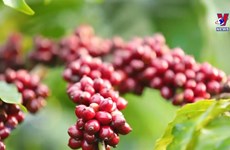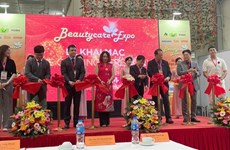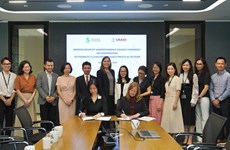Agricultural, craft products need GI protection
Tran Huu Nam, Deputy Director of the Industrial Property Office, told
Economic and Urban Affairs newspaper about geographical indications, a
term used to identify and protect products from a particular region.
Tran Huu Nam, Deputy Director of the Industrial Property Office, told
Economic and Urban Affairs newspaper about geographical indications, a
term used to identify and protect products from a particular region.
*Can you give us an explanation about the use of geographical indications in Vietnam to date?
According to incomplete statistics, by the end of 2010, Vietnam had a total of 944 geographical indications (GIs) for local products and services. Of these, the North had 361 GIs, the central 257 and the South 326. In 2001, we only had two GIs.
By August 31 this year, another 61 localities had submitted their registration requests, but only 41 were certified. Thirty eight GIs were granted by Vietnam and the other three by foreign countries. Vietnam now ranks second after Thailand on the number of products certified with GIs.
*Do you think this success reflects Vietnam's potential for exporting agro-forestry products and fisheries, which now have an annual export turnover of more than 20 billion USD?
Agriculture is our primary industry, with rich and diverse products, including traditional products such as rice, coffee and fruit (dragon fruit, litchi, Nam Roi and Phuc Trach pomelos). Endowed with a favourable tropical climate, Vietnam is rich in tropical fruit and their related products.
Many craft associations and traditional craft villages have also not paid enough attention to registering GIs for their products. It is high time for us to raise awareness among the people and local authorities on the benefits of the system.
*Will Vietnam and Vietnamese farmers be at a disadvantage position if their products don't have GIs?
No doubt! If our products have got their GIs, their selling prices will be much higher. But, we have to concede that many of our products have failed to meet domestic and foreign customers' requirements.
At present, we export mostly raw materials to foreign buyers. A case in point is our rice. It is sold at 410 USD per tonne. After importing our rice and doing some processing, including labelling, they sell one tonne for 1,200 USD.
This is a good lesson for us. I think we should pay more attention to science and technology, including introducing new and high quality rice to farmers.
I'm pretty sure, if our rice quality meets international standards and has a trade mark "Made in Vietnam", foreign customers would be willing to pay much more than 410 USD for one tonne.
Another example I want to mention is Buon Ma Thuot coffee. Due to lethargy in applying for GI certification internationally, the locality name of the coffee was lost to a Chinese company, but after a two-year court battle in China, the Chinese Ministry of Commerce revoke the patent of the Chinese company in Guangzhou.
The ministry agreed that the Chinese company had been falsely using the Vietnamese locality name. Following the decision, the Buon Ma Thuot body that represents growers in the region applied for trademark protection in 17 countries around the world.
In fact, the name Buon Ma Thuot coffee has not yet been used in the coffee distribution network in Vietnam. It has been sold as raw produce only. A Chinese company imported raw coffee from Buon Ma Thuot, processed it and sold it under the name Buon Ma Thuot coffee.
They knew that Buon Ma Thuot was a well-known coffee growing region in Vietnam, but they also knew the name had not been registered for GI internationally. This was an expensive lesson for Vietnam.
In many countries, including the United States, there is no need to apply for GIs for a product, but other types of legal registration are accepted, such as registration for the protection of collective trade marks and trade mark certification.
*Vietnam is in the process of negotiating a few important trade agreements, including the Trans Pacific Partnership Agreement, the Vietnam-EU Free Trade Area. How will the GIs registration in our country be affected?
GI registration work has been supported by Vietnamese authorities and international organisations, including the FAO or MUTRAP. In addition to support from the Vietnamese Government and international organisations, it is important to have engagement from local authorities, producers' associations or traditional craft villages.
But the first thing we have to do is to improve the quality of our products. For example, Hanoi now has more than 1,300 traditional craft villages and many special agricultural products, but none of them have registered for their GIs.
It is my suggestion that Hanoi authorities, particularly the Hanoi Department of Science and Technology, review what are the city's specific products to start their GIs registration or to ask for collective trade mark certifications or product certificates.-VNA
*Can you give us an explanation about the use of geographical indications in Vietnam to date?
According to incomplete statistics, by the end of 2010, Vietnam had a total of 944 geographical indications (GIs) for local products and services. Of these, the North had 361 GIs, the central 257 and the South 326. In 2001, we only had two GIs.
By August 31 this year, another 61 localities had submitted their registration requests, but only 41 were certified. Thirty eight GIs were granted by Vietnam and the other three by foreign countries. Vietnam now ranks second after Thailand on the number of products certified with GIs.
*Do you think this success reflects Vietnam's potential for exporting agro-forestry products and fisheries, which now have an annual export turnover of more than 20 billion USD?
Agriculture is our primary industry, with rich and diverse products, including traditional products such as rice, coffee and fruit (dragon fruit, litchi, Nam Roi and Phuc Trach pomelos). Endowed with a favourable tropical climate, Vietnam is rich in tropical fruit and their related products.
Many craft associations and traditional craft villages have also not paid enough attention to registering GIs for their products. It is high time for us to raise awareness among the people and local authorities on the benefits of the system.
*Will Vietnam and Vietnamese farmers be at a disadvantage position if their products don't have GIs?
No doubt! If our products have got their GIs, their selling prices will be much higher. But, we have to concede that many of our products have failed to meet domestic and foreign customers' requirements.
At present, we export mostly raw materials to foreign buyers. A case in point is our rice. It is sold at 410 USD per tonne. After importing our rice and doing some processing, including labelling, they sell one tonne for 1,200 USD.
This is a good lesson for us. I think we should pay more attention to science and technology, including introducing new and high quality rice to farmers.
I'm pretty sure, if our rice quality meets international standards and has a trade mark "Made in Vietnam", foreign customers would be willing to pay much more than 410 USD for one tonne.
Another example I want to mention is Buon Ma Thuot coffee. Due to lethargy in applying for GI certification internationally, the locality name of the coffee was lost to a Chinese company, but after a two-year court battle in China, the Chinese Ministry of Commerce revoke the patent of the Chinese company in Guangzhou.
The ministry agreed that the Chinese company had been falsely using the Vietnamese locality name. Following the decision, the Buon Ma Thuot body that represents growers in the region applied for trademark protection in 17 countries around the world.
In fact, the name Buon Ma Thuot coffee has not yet been used in the coffee distribution network in Vietnam. It has been sold as raw produce only. A Chinese company imported raw coffee from Buon Ma Thuot, processed it and sold it under the name Buon Ma Thuot coffee.
They knew that Buon Ma Thuot was a well-known coffee growing region in Vietnam, but they also knew the name had not been registered for GI internationally. This was an expensive lesson for Vietnam.
In many countries, including the United States, there is no need to apply for GIs for a product, but other types of legal registration are accepted, such as registration for the protection of collective trade marks and trade mark certification.
*Vietnam is in the process of negotiating a few important trade agreements, including the Trans Pacific Partnership Agreement, the Vietnam-EU Free Trade Area. How will the GIs registration in our country be affected?
GI registration work has been supported by Vietnamese authorities and international organisations, including the FAO or MUTRAP. In addition to support from the Vietnamese Government and international organisations, it is important to have engagement from local authorities, producers' associations or traditional craft villages.
But the first thing we have to do is to improve the quality of our products. For example, Hanoi now has more than 1,300 traditional craft villages and many special agricultural products, but none of them have registered for their GIs.
It is my suggestion that Hanoi authorities, particularly the Hanoi Department of Science and Technology, review what are the city's specific products to start their GIs registration or to ask for collective trade mark certifications or product certificates.-VNA













